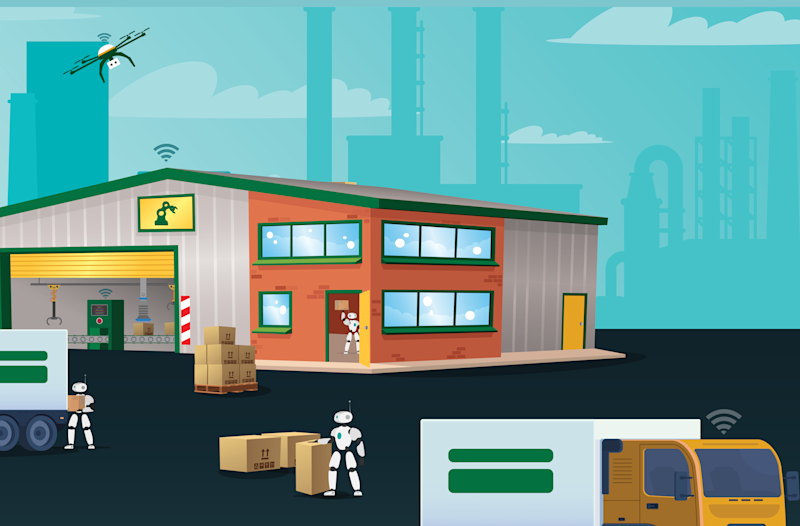Let’s face it: When it comes to things like video analytics, artificial intelligence and machine learning, autonomous mobile robots, and other advanced manufacturing technologies, it is very easy to figure that they’re being deployed with comparative ease in facilities of companies like General Motors, Boeing, or Caterpillar. After all, these are organizations that operate major manufacturing sites that have resources which can make many manufacturers awfully envious.
But here’s something to keep in mind: According to industry research organization IBISWorld, as of 2022, there are 638,583 manufacturing businesses in the United States. The greater part of that number consists of those with fewer than 500 employees, which is certainly not where GM, Boeing, and Caterpillar are in terms of headcount.
(Here’s a fun fact from the U.S. Small Business Administration: As of March 2021, there are 31.7 million small businesses in the United States across all industries (this number has risen to 33.2 million in 2023) and 20,139 large businesses, which means that small businesses represent 99.9% of all firms.)
Small Like All
So, what about video analytics, artificial intelligence and machine learning, autonomous mobile robots, and other advanced manufacturing technologies – do they have applicability in small businesses?
“One hundred percent yes,” Jason Bergstrom emphatically answers. And he ought to know. Bergstrom is the go-to-market smart factory leader for Deloitte Consulting. (He has also attained a Lean Six Sigma Master Black Belt certification, so he knows more than a little something about manufacturing efficiencies.)
Take video analytics. Bergstrom says the tech can be deployed in any size facility, whether it is a company the size of GM or a bracket manufacturer with one line and one facility that is supplying a company like GM. “Video analytics is about each step in the production line, improving quality.” As quality is a goal by a company of any size, the technology can be advantageous.
Robots present a similar case, he says, if the task is line side loading; then again, the size of the operation isn’t that important. “Other than economies of scale in terms of purchasing power, robots and cobots are just as deployable on a single line as they are in a facility with several.” He adds, “They are very applicable to small shops.”
Bergstrom does point out, however, that artificial intelligence and machine learning are more applicable to installations where there is more scale. “In order to program and drive those algorithms – the more lines and the larger the network, the better off your AI and machine learning will be.
“This is not to say smaller organizations can’t use them, but they’re more difficult to deploy, especially if it is in a single-threaded, single-line, mom-and-pop shop.”
That point segues into one where there is the question of labor.
“Whether you are big or small, our view is that there is a transition going on as we speak,” he says.
The Accelerating Transition
Bergstrom believes the transition is one where traditional manual labor operations are being increasingly replaced by automation, whether with robots or smarter conveyance devices.
Consequently, there is a need for the upskilling of individuals who will be taking on different roles within the operation and doing things like keeping the automation up and running.
This is going to be a transition that is not going to happen overnight but which will take some time as people are trained – many on the job – in order to take on these new roles.
“Whether you are big or small, the kinds of folks who are going to be running your operations are going to start to look different,” Bergstrom says.
However, there is something that Bergstrom underlines as being absolutely essential in terms of the transformation of the workforce into a cadre of people freshly graduated from a community college or a four-year program who come in to take care of operations – and it isn’t giving veteran employees a severance package.
Tribal Knowledge
“Most manufacturing jobs have technical components and functional knowledge-based, tribal knowledge-based components that you just can’t get rid of,” Bergstrom points out.
In other words, long-term employees simply know how things are done to get product out the door. This know-how is important. While there is much to be said for “big data” in terms of compiling and processing information, there is still lots to be said for what Sally or Joe know about the operations they’ve been performing for many years. This isn’t something that is written down in a spreadsheet somewhere but what has become intrinsic knowledge. Should they be shown the door, that goes with them.
Bergstrom says, “That knowledge is critical to products and services.”
A driver that organizations of all sizes need to take into account is something that was made most evident by the COVID-19 pandemic and subsequent supply chain problems:
“Whether it is onshoring or near-shoring, there is a need now for manufacturing to be close to the consumption point of the product.”
This is not just something for large operations but even for Tier 2 and Tier 3 suppliers to major corporations.
A key factor that this provides, Bergstrom says, is resiliency – to which smart manufacturing can contribute.
In recent years, the sourcing decisions of many manufacturing companies were largely predicated on labor arbitrage: where the lowest cost can be achieved. This is why there are so many components and products shipped from Asia.
Does Bergstrom think U.S. operations can be as competitive as those in places like Southeast Asia? “I absolutely do.”
He adds: “You have to define ‘competitive’ differently.”
Beyond Per-Unit Cost
Bergstrom says that “competitive” was historically defined as the “per-unit cost.”
“That is the wrong definition. If that is your definition, then it is likely your products are sitting in 40-foot containers off of Long Beach right now.”
Yes, he says, cost is an important factor.
But there is the resiliency factor, too: “You have to look across your supply portfolio. What are the choices you can make to assure a certain service level at a certain cost?”
Let’s take the proverbial widget. Let’s say it can be produced in a country like Vietnam for 3 cents and 10 cents in North America. Historically, the decision would be made to have all the widgets produced in Vietnam.
But let’s say that because of the deployment of smart manufacturing technology, an operation that is either based in North America or near-shore can produce the widget for 5 cents.
So, Bergstrom says that a company can build a portfolio with half its widget supply based in Vietnam and the other half from a domestic or near-domestic operation.
“Now you have a resilient supply of product at 4 cents rather than 3 cents. You may be taking a cost hit, but you’re doing it in a way that probably quadruples your resilience to market shock.”
He adds: “I would say it only works if you’re paired up with smart manufacturing.”
New Tech for New Tech
According to the American Automotive Policy Council (AAPC), “automakers and their suppliers are America’s largest manufacturing sector, responsible for 3% of America’s GDP. No other manufacturing sector generates as many American jobs. Not only are they America’s largest exporters, they also buy hundreds of billions of dollars worth of American steel, glass, rubber, iron, and semiconductors each year.”
Which means U.S.-based automakers and suppliers make a lot of products and buy a lot of products to make those utility vehicles, trucks, and cars.
Presently, GM is investing $35 billion in the development of electric and autonomous vehicles. It started the spend in 2020 and will complete by 2025.
Ford recently announced that it is spending $50 billion on electric and other vehicle technologies by 2026.
Those AAPC stats didn’t take numbers like these into account because this is a space that is changing rapidly.
The point is that there are hundreds of suppliers that are going to be affected by this transition from 100% internal combustion engines (ICEs) to propulsion systems that are either all-electric or significantly electrified (i.e., hybrids).
So, what happens to one’s business if it has been 100% dependent on ICEs? It is significantly downsized – or completely downsized – unless there is a transition to producing something else.
Bergstrom points out: “Depending on how close the new product is to the one you’re making, you do have more agility with the smart factory.” Having advanced tech in place and an upskilled workforce won’t mean the transition to producing for the electrified auto industry will be easy – but it will mean that it will be easier than it would be otherwise.
Time Compression
To pull the focus out to encompass other industries, Bergstrom says that they’re seeing a compression in the amount of time that companies are taking to transition to smart manufacturing – regardless of the size of the company.
“There used to be a large amount of time between early adopters and call it your ‘second tranche’ of followers. That’s no longer happening.”
He adds, pointedly, “The lion’s share in tranche two or three have had their time compressed – they can’t afford to wait. The pandemic has driven a lot of this, and a lot of it is about supply chain.
“They’re having to really accelerate their thoughts about digitizing operations in order to be successful.”
He sums it quite succinctly: “Time is of the essence to compete and be successful.”






